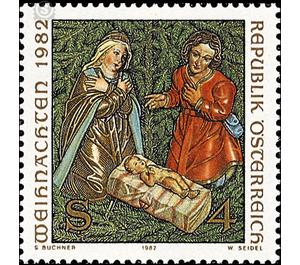Christmas - Austria / II. Republic of Austria 1982 - 4 Shilling
Theme: Calender
| Country | Austria / II. Republic of Austria |
| Issue Date | 1982 |
| Face Value | 4.00 |
| Color | multi-colored green |
| Printing Type | combination printing |
| Stamp Type | Commemorative |
| Item Type | Stamp |
| Chronological Issue Number | 1067 |
| Chronological Chapter | OOS-OE2 |
| SID | 620330 |
| In 75 Wishlists | |
The Christmas stamp 1982 shows the nativity scene in the church Damüls in Vorarlberg. The Damülser nativity scene together with the Pestaltar from 1630 and the Rosary altar are a group of works attributed to the Feldkirch early baroque sculptor Erasmus Kern and thus fall into the second quarter of the 17th century. The crib figures of the Damülser nativity scene are all carved wood. The baby Jesus is lying on a little bed, with his mother Mary and a young shepherd standing beside him. Josephvertritt. Common to the figure of St. Maria and the shepherd detailing the clothing, a narrow crease falling from the center of the belt. Over the flat, box-like bed of the child is a relief-like cloth with naturalistic colors, which falls down at the foot and to the right of the child. On the untreated longitudinal side of the bed is the words "Renovated in the year of Christ 1742" to read. Erasmus Kern's work fell into the era of the Counter-Reformation. Was worn elsewhere by the Jesuits, there was a Capuchin Monastery since 1605, where also the St. Fidelis of Sigmaringen as Gurdian worked. It is obvious that the baroque soulful nativity scene was promoted by this popular order.


